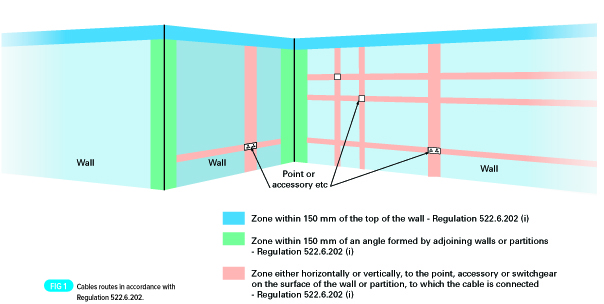Where is it DANGEROUS to drill in a Wall?
This is, understandably, a very important thing to know. There are 3 main areas where you can definitely expect cables to have been run:

1. Where two walls meet
An area 150mm (6 inches) wide along the top of the wall where it meets the ceiling.
2. Horizontally either side of a switch or socket
In a straight line either side of a socket/switch/fused spur etc. The line is the height of the socket/switch. It runs all the way to the adjoining walls, or an obstacle, such as door or window.
3. Vertically above and below a Socket or Switch
In a straight line above and below a socket/switch/fused spur etc. The line is the width of the socket/switch. It runs all the way to the floor and ceiling.
Very Important:
If the wall is less than 100mm (4 inches) thick, then the safe zones operate on both sides of the wall. Bear this in mind when you are drilling from a different room!
Very Very Important:
Electricians in the past did not have these rules. Cables could be, and were run in all sorts of odd places.
We have found cables run diagonally across walls, doing sudden 90 degree bends and all sorts, so beware.
If you suspect that someone in the past has carried out some electrical DIY work in your house, it is quite possible that they did not know about Safe Zones. They may have run cables wherever was most convenient for them, not always in the safest place.
If your current consumer unit does not have a functioning, healthy RCD, in fact, if you have any doubts at all,
TURN OFF THE CONSUMER UNIT BEFORE YOU DRILL
Where is it safe to drill in a Ceiling?
The rule that electricians should follow is to run the cables through the joists, as close to the centre of the joist as possible, at a depth of at least 50mm from the top and bottom of the joist. i.e 50mm from the ceiling/floor.
It is not always possible to follow this rule. There are often existing holes and notches in a joist. It is extremely likely that in the past, cables will have been run all over the place.
It is also quite possible that cables can be lying on top of plasterboard ceilings.
Because it is not always possible to run cables this way, the current electrical regulations allow cables to be run outside the zones, provided they are protected by an RCD.
If the wiring in your house is old and you have a Consumer Unit which does not have an RCD, then you should be even more cautious.
If you have any doubts…..
TURN OFF THE CONSUMER UNIT BEFORE YOU DRILL
Where is it safe to drill in a Floor?
As with ceilings, the rule that electricians should follow is to run the cables through the joists, as close to the centre of the joist as possible, at a depth of at least 50mm from the top and bottom of the joist. i.e 50mm from the floor.
It is not always possible to follow this rule. There are often existing holes and notches in joist, and it is extremely likely that in times past, cables have been run all over the place. It is also extremely likely that gas & water pipes have also been run under the floorboards through notches in the joists, (in which case, it is worth checking very very carefully first)
Because it is not always possible to run cables this way, the current electrical regulations allow cables to be run outside the zones, provided they are protected by an RCD.
If the wiring in your house is old and you have a Consumer Unit which does not have an RCD, then you should be even more cautious.
If you have any doubt,
If you have any doubts…..
TURN OFF THE CONSUMER UNIT BEFORE YOU DRILL
